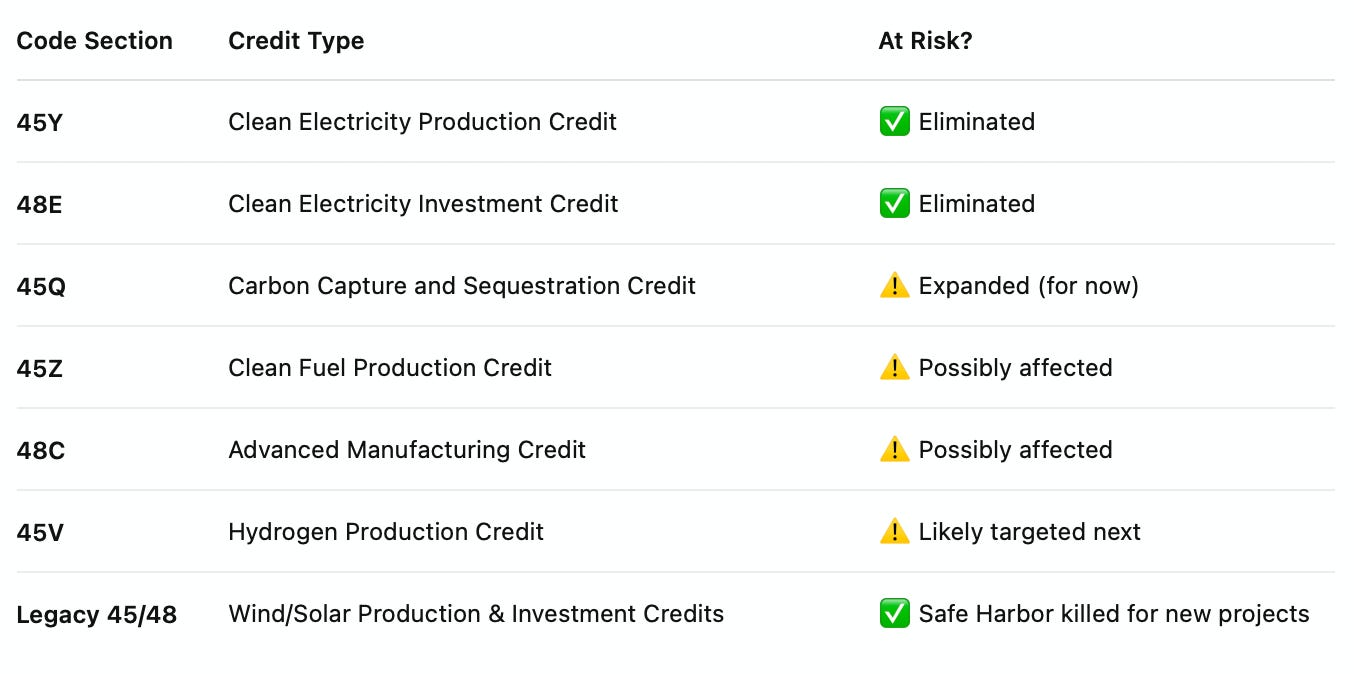BREAKING: Treasury Issues Guidance on Wind and Solar Subsidies
The 5% Safe Harbor is dead (except for rooftop solar), and with it goes the speculative subsidy-driven gold rush.
On August 15, the U.S. Treasury Department released Notice 2025-42, a major piece of guidance that will reshape the future of wind and solar tax credits. This notice fulfills mandates from Executive Order 14315 and the One Big Beautiful Bill Act (OBBBA) and delivers on the Trump administration's commitment to end corporate welfare for unreliable energy sources.
The guidance confirms what many expected, and what the energy subsidy crowd feared: the 5% Safe Harbor is gone for large-scale wind and solar facilities.
What This Means
Effective September 2, 2025, developers of wind and solar projects can no longer qualify for Sections 45Y or 48E tax credits simply by spending 5% of total project costs. Instead, they must satisfy the Physical Work Test, showing that real, on-site or contracted construction work of a significant nature has begun before July 5, 2026, and that construction continues without interruption.
The only exception: small low-output solar facilities under 1.5 megawatts AC can still use the 5% Safe Harbor.
This is a strategic and surgical rollback of the Inflation Reduction Act's (IRA) so-called "clean energy" subsidies.
Why It Matters
For over a decade, green developers and tax equity financiers have gamed the system, locking in credits with minimal up-front investment, then delaying projects for years. That game is over.
In the words of Secretary of Energy Chris Wright:
"[I]ntermittent power sources are a parasite on the grid."
This guidance helps constrain that parasite's growth by choking off the tax-driven speculation that fueled it.
Chart: What Credits Use the 5% Safe Harbor?
Looking Ahead
This is just the first shoe to drop. Treasury is still working on additional guidance to enforce new Foreign Entity of Concern (FEOC) restrictions, which could further restrict subsidy access for Chinese-connected firms and ESG-aligned investors.
Meanwhile, carbon capture credits massively expanded under Biden were expanded again in the OBBBA, and that’s infuriating. At the same time the Trump administration is working to rescind the EPA’s Endangerment Finding and DOE releases reports like “A Critical Review of Impacts of Greenhouse Gas Emissions on the U.S. Climate,” we’re still throwing tax dollars at CO₂ capture schemes.
If CO₂ is no longer a pollutant under federal law, doesn’t impact human health or the environment, then there is absolutely no justification for subsidizing carbon capture. It’s pure grift.
Worse still, the 45Q program now pays up to $85 per ton for CO₂ used in enhanced oil recovery — a greater than 40% increase from the IRA, which already hiked it from $35 to $60 per ton. Wow! $85/ton! Taxpayers are essentially funding oil production with climate dollars. Big Oil lobbied hard to keep the carveout — and wound up with an expansion.
If they need CO₂ to get more oil out of the ground, they can pay for it themselves. Taxpayers shouldn’t be on the hook for Big Oil to meet their Paris pledges through a fake climate fix that enriches corporations, increases the cost of everything, and solves nothing.
Sabotage from Within?
While the White House and Treasury are moving decisively to shut down the clean energy subsidy machine, a some Senate Republicans are holding up the effort.
Sens. Chuck Grassley (R-Iowa) and John Curtis (R-Utah) are placing holds on three of President Trump’s Treasury Department nominees — Brian Morrissey Jr., Francis Brooke, and Jonathan McKernan — in protest of the very rules that implement the law Trump signed.
Grassley even entered his objection into the congressional record, saying he would block the nominations until Treasury’s wind and solar guidance meets his interpretation of "congressional intent."
This obstruction undermines the America First agenda. The OBBBA and EO 14315 were passed and signed into law to end green corporate welfare and restore balance to our energy markets. It's unfortunate that some Republicans still appear more loyal to the subsidy lobby than to American energy security.
Final Thought
Treasury's Notice 2025-42 is a welcome course correction. It begins the process of dismantling a decade of bad energy policy built on speculative finance and political ideology. American energy should be built on reliability and value — not on subsidies and virtue signaling.
The result should be better economics for affordable and reliable electric generation powered by natural gas, coal, and nuclear.
More to come.
For more policy breakdowns like this, subscribe to the American Energy Institute’s Substack.





